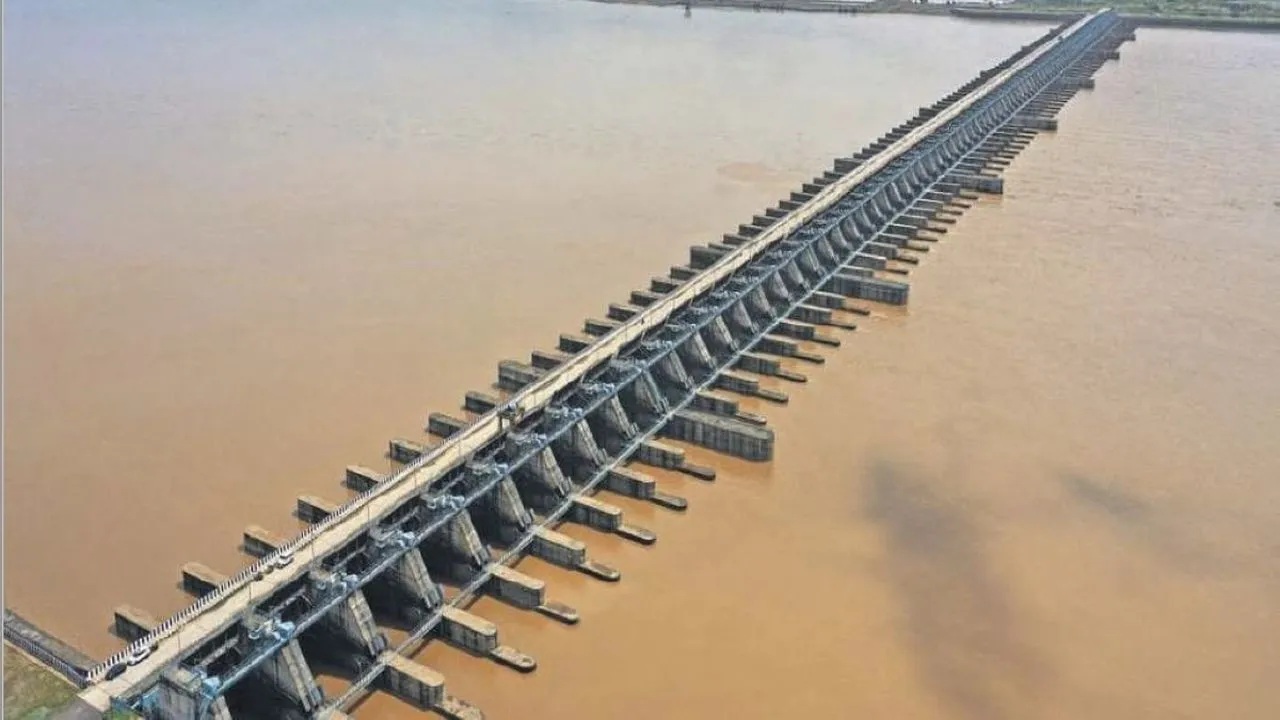AIMIM's Akbaruddin Owaisi recently questioned the government's conflicting statements, asking whether ministers viewed Kaleshwaram as a success or a scam.
Published Sep 09, 2025 | 9:00 AM ⚊ Updated Sep 09, 2025 | 9:00 AM

File photo of Medigadda barrage.
Synopsis: Even as Telangana Chief Minister A Revanth Reddy harped on the ‘monumental failure’ in implementing the Kaleshwaram Lift Irrigation Project, he kick-started a scheme to utilise water from Mallanna Sagar. The opposition parties wonder if water from Mallana Sagar could be used if the Kaleshwaram project is a failure, as projected by the government. The government owes a clarification.
Is the Kaleshwaram Lift Irrigation Project (KLIP) a dud — or still useful — even after the sinking of the Medigadda barrage piers, a key component of the scheme?
If it is a dud, how could Telangana Chief Minister A Revanth Reddy lay the foundation stone for the Godavari Drinking Water and Musi Rejuvenation Projects, which proposed the utilisation of 20 Tmcft (thousand million cubic feet) of water from Mallanna Sagar, an integral part of KLIP?
The event, held at Gandipet in Hyderabad on Monday, 8 September, amidst a growing political controversy, catapulted the inconsistencies in the Congress’s stance on KLIP into public focus. Even while terming the project a disaster, the government said it will utilise water from Mallanna Sagar for the rejuvenation of Musi and to provide drinking water to Hyderabad.
The Musi rejuvenation effort seeks to clean up the Musi River with fresh water. Under the new scheme, 20 Tmcft of water will be drawn from the Mallanna Sagar reservoir, the core part of KLIP, to replenish the Osman Sagar and Himayat Sagar reservoirs.
Of this allocation, 4 Tmcft is meant for Musi rejuvenation, with the remaining 16 Tmcft for Hyderabad’s drinking water requirements. Seven smaller lakes along the route will also benefit from the inflow.
The project, estimated at ₹7,360 crore, will be executed under the Hybrid Annuity Model (HAM), with the government contributing 40 percent of the funding and the contracting agency covering the remaining 60 percent. Officials have set a deadline of December 2027 to complete the project, promising a piped water supply to every household in Hyderabad.
However, the reliance on KLIP infrastructure has drawn sharp criticism from opposition parties, who accused the Congress of “double speak.”
While in the opposition earlier, the Congress had repeatedly condemned the Kaleshwaram project — built under the previous Bharat Rashtra Samithi (BRS) regime — as one riddled with corruption, engineering flaws, and financial mismanagement.
Incidents such as the sinking of piers at the Medigadda barrage fuelled charges of it being a “monumental failure.” A week ago, the state government referred the alleged irregularities in the project’s construction to a CBI probe. Revanth Reddy also vowed to hold those responsible accountable.
Critics, including BRS leaders and the All India Majlis-e-Ittehadul Muslimeen (AIMIM) floor leader, Akbaruddin Owaisi, highlighted the apparent contradiction. Owaisi recently questioned the government’s conflicting statements, asking whether ministers viewed Kaleshwaram as a success or a scam.
“Whom should I believe?” he asked in the Assembly, pointing to discrepancies in official narratives. BRS has defended KLIP, arguing that Congress’s decision to utilise its waters validates the project’s value while undermining its previous attacks.
The Telangana government has allocated ₹1,500 crore for the Musi Riverfront Development Corporation Limited (MRDCL) in the 2025-26 budget. As of August, ₹375 crore has been released as the second-quarter installment to support river beautification, pollution control, and urban infrastructure enhancements.
While the overall Musi rejuvenation has been projected to cost upwards of ₹1.5 lakh crore in the long term, specific details on the full funding breakdown were being worked out. The detailed project report (DPR) is expected within 18 months from a selected consortium at a cost of ₹141 crore.
The project faced additional scrutiny over potential displacements along the riverbanks, with opposition leaders like BRS working president KT Rama Rao alleging it prioritises real estate interests over residents.
Earlier, Revanth Reddy dared critics to live on the Musi banks for three months to understand the pollution’s severity. He vowed to abandon the plan if they took up the challenge.
At the Gandipet event, Revanth Reddy, however, refuted the BRS’s contention that the government was using Kaleshwaram infrastructure. He said that the Hyderabad Drinking Water and Musi Rejuvenation projects would utilise Kaleshwaram water, transferred from the Sripada Yellampalli project, constructed during the previous Congress regime.
Kaleshwaram is just three barrages: Medigadda, Sundilla, and Annaram, of which Medigadda’s piers had collapsed, he said.
(Edited by Majnu Babu).
